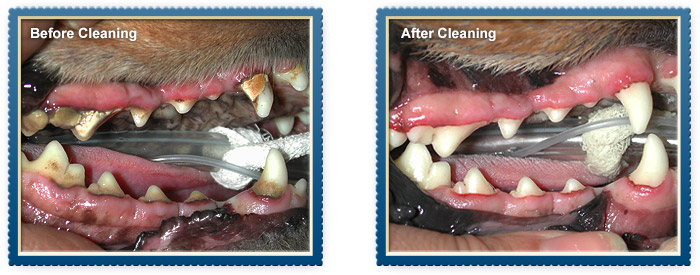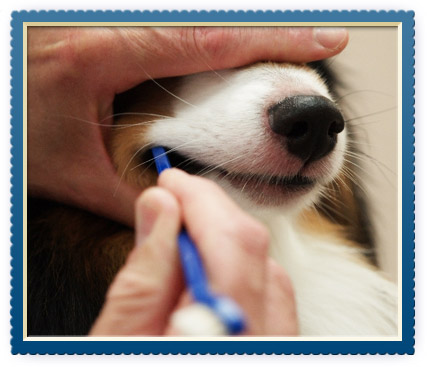Pet Dental Care
Why is Dental Care So Important for My Pet?
Did you know that 80% of animals over five years of age have some form of dental disease? If left untreated, dental disease can not only be painful and inhibit proper nutrition, it can also lead to serious systemic issues that may threaten your pet's health before symptoms are noticeable.
To be sure you're doing all you can to protect your pet's health, make regular dental examinations and cleanings at Animal Hospital of Ivy Square a part of your pet's regular preventive care plan. We offer complete pet dental care, including preventive care and cleanings, digital dental radiology, surgical dentistry and oral tumor management. You can feel confident knowing we utilize the latest techniques and modern technology to provide the best dental care for your pet.

Ten Steps to a Healthy Mouth
- Physical examination. An oral examination is performed as part of your pet's general physical examination. If we see signs of dental disease, we will grade the severity on a scale of one to four, with one being minor dental problems and four being major dental problems. This gives us a rough idea of what we may need to do during a dental procedure. It is difficult to fully examine the mouth of an awake pet and we can only see the crowns of the teeth, not the roots. Based on what we see, we will provide a rough estimate for your pet's dental appointment. If more problems are found during the dental procedure, we will call you to discuss our findings and provide the revised cost.
- Preoperative blood work and examination. When your pet receives general anesthesia at Animal Hospital of Ivy Square, a full physical examination and blood tests are performed beforehand to make sure he or she is in good health.
- General anesthesia. Dentistry requires an animal to be under general anesthesia. A licensed veterinary technician closely monitors your patient during the dental procedure.
- Intraoral Digital Radiology. During your pet's dental examination, we use Midmark Progeny Digital Radiology technology, which provides nearly instantaneous, highly detailed images of your pet's oral cavity. The only way to accurately evaluate the whole tooth is with an X-ray. The crown is the only portion of the tooth visible - the root of the tooth is embedded in a socket in the jaw bone. In many cases the crown of the tooth may appear normal, but an X-ray of the tooth may reveal a problem with the root that requires treatment. We can also transmit your pet's X-rays to specialists for second opinions on diagnostic and treatment plans and email a copy to you as well. If your pet's tooth needs to be extracted, we will take a follow-up X-ray to make sure the entire root has been removed and there is no damage to the jaw bone.
- Scaling. Scaling removes tartar from your pet's teeth. Tartar, which is produced by bacteria that live on your pet's teeth, causes inflammation of the gums (gingivitis) leading to recession, exposure of the tooth roots and eventually tooth loss. We remove the tartar with a combination of an ultrasonic scaler and hand scaling just like the human dental hygienists. Removal of the tartar on the teeth is vital to improving the health of the mouth and keeping your pet's breath smelling fresh.
- Periodontal probing. After your pet's teeth have been scaled, the veterinarian looks for pockets around each tooth using a periodontal probe. Pockets are caused by the gum losing its attachment to the tooth. Bacteria and tartar can accumulate in the pocket, causing the wall of the tooth socket to erode. This leads to loosening of the tooth and eventually to tooth loss. A small pocket may be cleaned and flushed, but a deep pocket usually requires that the affected tooth is removed.
- Charting. The combination of digital radiology and periodontal probing allows us to accurately diagnose any problems with your pet's teeth and formulate a treatment plan. We use a special chart to record our findings and treatments.
- Extractions. If we decide your pet's tooth cannot be saved, it will be extracted. The first step is to place a local anesthetic block. Though your pet will also be under general anesthesia, the local block gives your pet immediate pain relief that lasts for several hours to offer postoperative comfort. Once the block has taken effect, we elevate a flap of gum tissue to expose the jaw bone. A high speed drill is used to cut the tooth into sections to allow for easier removal. Once the tooth is removed the socket is cleaned. A post extraction x-ray is taken to make sure all of the roots have been removed. Once we have confirmed there are no tooth root remnants, we close over the socket using the gum flap. This prevents food material from becoming lodged in the empty socket. The flap is sutured with a fine absorbable suture.
- Sealant. Once the scaling and any periodontal treatments are completed, we recommend application of Sanos sealant to your pet's teeth. This sealant helps to prevent bacteria and plaque from getting under the gum line, into the gingival sulcus, where the process of periodontal disease begins. It does not prevent the plaque or tarter from forming, but it keeps it from causing damage to the periodontal surfaces. It is applied while your pet is still under anesthesia, after the tooth surface is clean and dry.
- Postoperative care. You will be provided with postoperative instructions. This may include soft food and no tooth brushing for a few days. We will discuss treatment options designed to reduce the accumulation of tartar on your pet's teeth. The treatment options may include a combination of tooth brushing, Oravet dental chews for dogs, special dental diets and oral rinses. The VOHC website has a list of approved products that have proven benefit to reduce plaque and/or tarter build up.
Caring for Your Pet's Teeth at Home
At home, please brush your pet's teeth regularly and check for signs of problems. Brushing your pet's teeth is the single most important way to maintain your companion's good oral health. If performed regularly, brushing your pet's teeth dramatically decreases the incidence of gingivitis and can increase the interval between teeth cleaning appointments.
 If you are unsure of how to brush your pet's teeth, please ask a member of the staff at Animal Hospital of Ivy Square for instructions. We are happy to help!
If you are unsure of how to brush your pet's teeth, please ask a member of the staff at Animal Hospital of Ivy Square for instructions. We are happy to help!
Signs of Pet Dental Problems
Symptoms of dental disease include:
- Bad breath (one of the first signs of dental disease)
- A yellowish-brown crust of plaque on the teeth near the gum line
- Red and swollen gums
- Pain or bleeding when your pet eats or when the mouth or gums are touched
- Decreased appetite or difficulty eating
- Loose or missing teeth
If your pet is experiencing any of the above symptoms, his or her overall well-being and health is also being impacted. Don't wait - please call us today for an appointment.